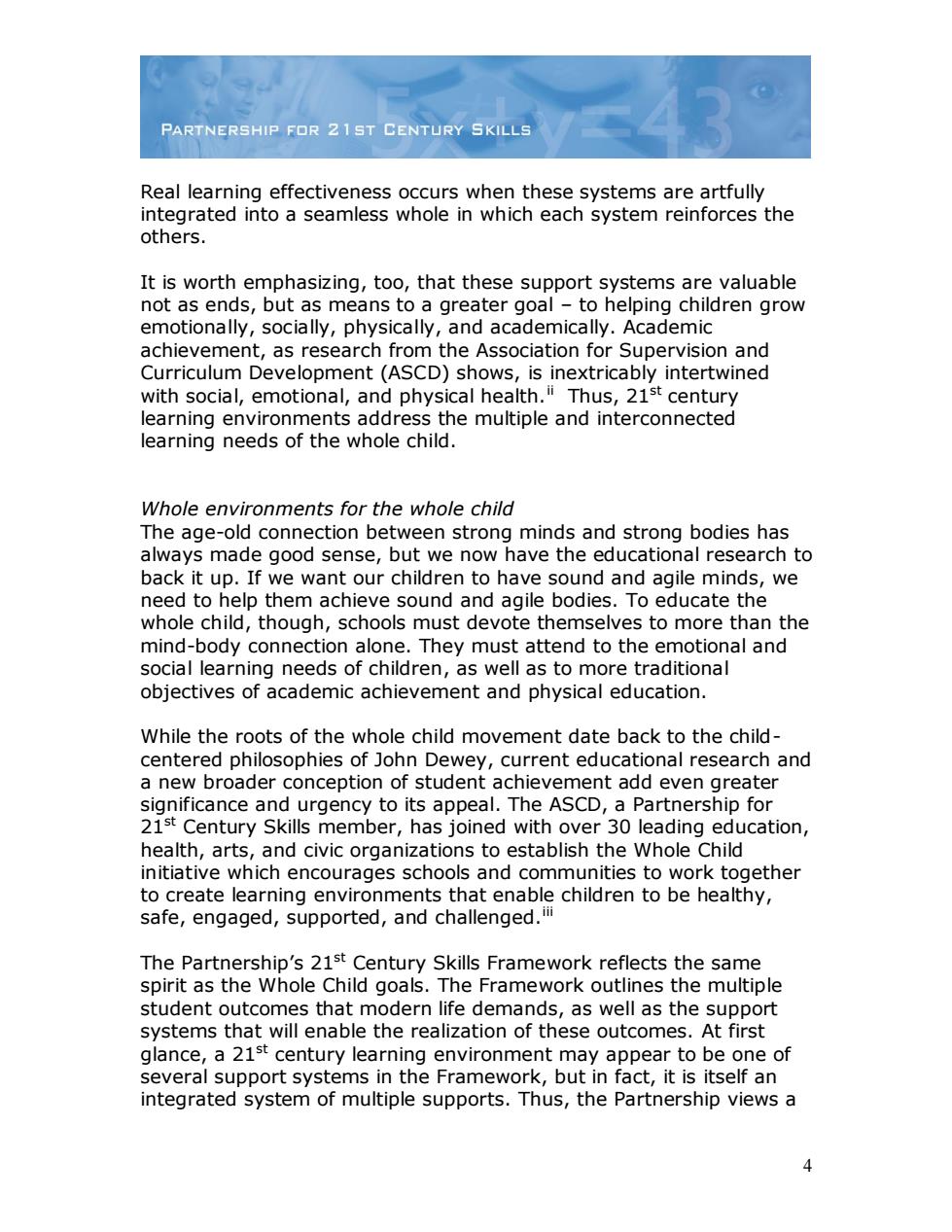正在加载图片...

PARTNERSHIP FOR 21ST CENTURY SKILLS Real learnin g effectiveness occurs when these systems are artfully integrated into a seamless whole in which each system reinforces the others. It is worth emphasizing,too,that these support systems are valuable not as ends,but as means to a greater goal-to helping children grow emotionally,socially,physically,and academically.Academic achievement,as research the Association for Supervision and Curriculum Development(ASCD)shows,is inextricably intertwined with social,emotional,and physical health.Thus,21st century learning environments address the multiple and interconnected learnina needs of the whole child. Whole environments for the whole child The age-old connection between strong minds and strong bodies has always made good sense,but we now have the educational research to back it up.If we want our children to have sound and agile minds,we nee to them sound nd agile b To edu the whole child,though,schools must devote themselves to more than the mind-body connection alone.They must attend to the emotional and social learning needs of children,as well as to more traditional objectives of academic achievement and physical education. While the ots of the whole child movement date back to the child centered philosophies of John Dewey,current educational research and a new broader conception of student achievement add even greater significance and urgency to its appeal.The ASCD,a Partnership for 21st Century Skills member,has joined with over 30 leading education, health,arts,and civic organizations to establish the Whole Child initiative which encourages sch and co work to ether to create learning environments that enabl e children to be healthy, safe,engaged,supported,and challenged. The Partnership's 215t Century Skills Framework reflects the same spirit as the Whole Child goals.The Framework outlines the multiple student o tha dern life em as well as the s systems that will enable the realization of these outcomes.At first glance,a 21st century learning environment may appear to be one of several support systems in the Framework,but in fact,it is itself an integrated system of multiple supports.Thus,the Partnership views a4 Real learning effectiveness occurs when these systems are artfully integrated into a seamless whole in which each system reinforces the others. It is worth emphasizing, too, that these support systems are valuable not as ends, but as means to a greater goal – to helping children grow emotionally, socially, physically, and academically. Academic achievement, as research from the Association for Supervision and Curriculum Development (ASCD) shows, is inextricably intertwined with social, emotional, and physical health.ii Thus, 21st century learning environments address the multiple and interconnected learning needs of the whole child. Whole environments for the whole child The age-old connection between strong minds and strong bodies has always made good sense, but we now have the educational research to back it up. If we want our children to have sound and agile minds, we need to help them achieve sound and agile bodies. To educate the whole child, though, schools must devote themselves to more than the mind-body connection alone. They must attend to the emotional and social learning needs of children, as well as to more traditional objectives of academic achievement and physical education. While the roots of the whole child movement date back to the childcentered philosophies of John Dewey, current educational research and a new broader conception of student achievement add even greater significance and urgency to its appeal. The ASCD, a Partnership for 21st Century Skills member, has joined with over 30 leading education, health, arts, and civic organizations to establish the Whole Child initiative which encourages schools and communities to work together to create learning environments that enable children to be healthy, safe, engaged, supported, and challenged.iii The Partnership‟s 21st Century Skills Framework reflects the same spirit as the Whole Child goals. The Framework outlines the multiple student outcomes that modern life demands, as well as the support systems that will enable the realization of these outcomes. At first glance, a 21st century learning environment may appear to be one of several support systems in the Framework, but in fact, it is itself an integrated system of multiple supports. Thus, the Partnership views a